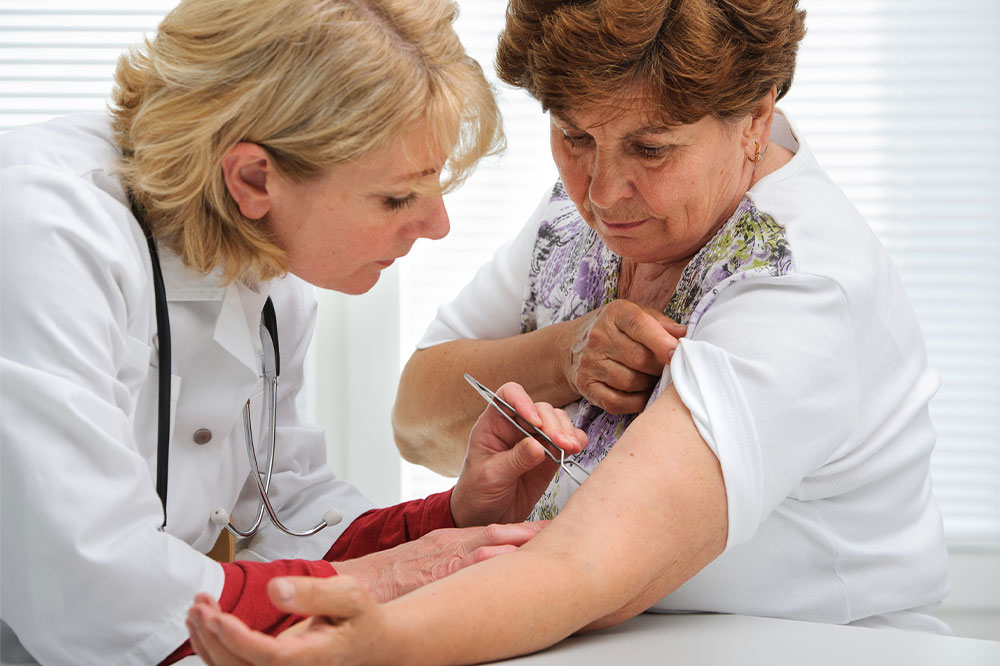
Hansen’s disease – Causes, symptoms, and management
Hansen’s disease (leprosy) is an infection affecting the skin, nose lining, nerves, and eyes and triggered by Mycobacterium leprae- a slow-growing bacteria. Once considered contagious, this condition does not spread quickly now, and the treatment is effective and usually easier with early diagnosis. Leprosy patients can lead an active lifestyle during and after the treatment. However, if untreated, Hansen’s disease might result in nerve damage and cause blindness, paralysis, and crippling feet and hands.
Symptoms
The condition mainly affects the mucous membranes, nerves, and skin. Patients may experience signs like-
- Stiff, thick, or dry skin
- Painless lumps or swelling on the earlobes or face
- Painless ulcers on the feet
- Discolored skin patches that are usually flat and may appear faded and numb.
- Nodules or growth on the skin
- Loss of eyelashes or eyebrows
If leprosy damages the nerves, it may result in the following symptoms-
- Eye problems resulting in blindness if facial nerves are affected
- Paralysis or muscle weakness, especially in the feet and hands
- Enlarged nerves, especially around the knees and elbows and on the side of the neck
- Numbness in the affected skin areas
When Hansen’s disease affects the mucous membrane, it might lead to the following symptoms-
- Nosebleeds
- Stuffy nose
Because this disease mainly affects the nerves, the infected person might experience a loss of sensation or feeling. Hence, injuries like burns might go unnoticed. Since one might not experience pain to warn the body about any harm, it is advised to exercise caution and routinely examine the affected areas. Not getting treated soon might lead to the symptoms progressing, resulting in symptoms like-
- Loss of eyebrows
- Blindness
- Crippling and paralysis of feet and hands
- Nose disfigurement
- Shortening of fingers and toes because of reabsorption
- Non-healing chronic ulcers at the bottom of the feet
Besides this, other complications a patient might experience are-
- Burning sensation in the skin
- Pain and redness around the affected area
- Tender or painful nerves
Causes
Mycobacterium leprae, a slow-growing bacteria, causes Hansen’s disease. There is no clarity on how it transmits. However, when an infected person sneezes or coughs, they may spread the droplets containing the bacteria in the air, which a nearby person might inhale. For transmission, close physical contact with an infected person is necessary. Thus, it does not spread by casual contact with an infected person, such as sitting with them at a table during lunch or on a bus, hugging, and shaking hands. Furthermore, pregnant mothers with leprosy do not pass it on to their unborn children.
Treatment
Today, treatment options exist to cure Hansen’s disease. Research indicates that nearly 16 million people with Hansen’s disease have been cured in the last twenty years. Primarily, the treatment will depend on the form of leprosy. Prescription remedies can help with the infection. But the disease demands long-term care for six months to a year. People with more severe leprosy might have to continue prescription treatment for longer. However, it is pertinent to note that this treatment will not cure the nerve damage caused by the condition.
Usually, doctors will advise combining multiple treatment options to cure Hansen’s disease. They may also advise anti-inflammatory options to help with the leprosy-inflicted damage and to control nerve pain.
Prevention
Early diagnosis is one of the best ways to prevent one’s risk of getting affected by the condition. Early and prompt therapy prevents further damage to the tissues, delays the spread of the condition, and controls severe health complications. Furthermore, if you are around an infected person, maintain a safe distance to prevent airborne particles from entering your body. Seek a healthcare professional’s advice about the best ways to keep the condition’s symptoms at bay.
As mentioned earlier, left untreated, Hansen’s disease can pave the way for severe health complications such as paralysis, non-healing ulcers, and the crippling of hands and feet. Therefore, it is advised to look out for the warning signs of the condition for early detection and management.




